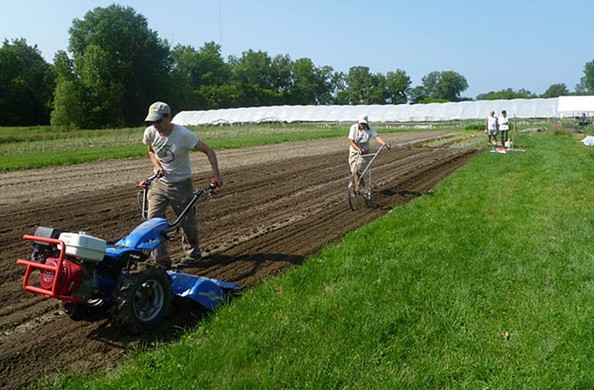By Lynn Zanardi Blevins, M.D., M.P.H.
It can be hard to get excited about soil this time of year. I can see my cross-country skiing season come to an end and my mud room is, well, just that. Soil often doesn’t get the credit it deserves for its life-supporting functions, but the 2015 International Year of Soils aims to turn that around by “increasing awareness and understanding of the importance of soil for food security and essential ecosystem functions.”
From a public health perspective, I’ve always felt that soil has been short-changed. Look in any introductory environmental health text book and you will find a chapter on air and one on water, but not much on soils, except a mention of the contaminated ones or a description on how septic systems function. The discipline of environmental health has long been concerned with the many hazards (e.g., heavy metals, infectious agents, radiation) which can negatively impact health. More recently, there has been emphasis on elements of our natural and built environment that promote health. Surely soils should be on this list, but it still isn’t in the book.
The Impact of Soil Health on the Environment
So, I reached for a soils text to make the soil-health connection. Here, I found the following six functions of soils:
- Medium for plant growth
- Regulator of water supplies
- Recycler of raw materials
- Modifier of the atmosphere
- Engineering medium
- Habitat for soil organisms
Soil as a medium for plant growth
With the exception of food harvested from oceans and hydroponic systems, soil plays a role in growing our food by supporting plant growth. This is not just for vegetarians. Meat eaters have diets that are just as plant-dependent as vegans; in fact it typically takes more plant material to feed the animals eaten by humans than if the humans just ate the plants straight up. Since humans obtain mineral nutrients from the soil via plants (or plant-eating animals), nutrition and food security depend on our ability to protect and maintain high-quality soils.
The soil–plant–food–health connection may not be news to you, but consider that the human population is expected to continue to increase, while the amount of soil is expected to continue to decrease due to soil loss through erosion, desertification, development, and urbanization.
Soil as a regulator of water supplies
Water runs through and over soil surfaces on its way to ground and surface waters. The quality of the soil can determine its ability to purify water and the resulting contaminants that flow into these waters. For a close-to-home example, consider the function of the soil in purifying the effluent from a septic drain field before it reaches the groundwater. Homes with septic systems usually also have wells, which tap into nearby groundwater as a source of potable water. Drink up!
Soil as a recycler of raw materials
Think of the mess the world would be without the recycling function of soil. We’d be up way over our heads indead-plant waste, animal corpses, and manure, which can harbor human pathogens. This is clearly not good for public health. In fact, without recycling of nutrients, earth would have run out long ago, and I’m pretty sure I wouldn’t be here writing this blog on the importance of soil to public health.
Soil as a modifier of the atmosphere
During the Dust Bowl, Franklin D. Roosevelt said, “A nation that destroys its soils destroys itself.” It was during this time that the Soil Conservation Service was established to control the soil erosion that led to the dust storms and flooding in the United States. We now face the global challenge of increased atmospheric carbon dioxide. Soils are recognized for their ability to sequester carbon to mitigate climate change (bonus: practices that enhance soil carbon sequestration can also restore degraded soils).
Soil as an engineering medium
Thomas Jefferson said “…civilization itself rests upon the soil.” Not only do we rest upon it, but we also build with it. It is estimated that half the world population lives or works in a building made of earth, including mud, cob, and brick. Many others are built using soil-dependent plant matter, such as wood.
Soil as habitat for soil organisms
Soils aren’t what ecosystems are built on; they are ecosystems in and of themselves. Minerals, water, air, and organic matter create a habitat for a diversity of microbes, animals, and the underground parts of most plants. Trees, shrubs, and other plants might have just as much tissue below the ground as they do above it. Some of our existing commonly used antibiotics and anticancer drugs have their origins in soil microbes. A recently identified antibiotic of soil origin shows promise in killing bacteria with resistance to other antibiotics. Realizing the potential of soil, Drugs From Dirt receives soil specimens from citizen scientists around the United States to profile the soil metagenome and guide the discovery of new antibiotic compounds.
The health and protection of our soils need to be part of our public health agenda. We will rightfully continue our disease prevention efforts related to lead-contaminated soil and soil-borne human pathogens, but we also need to better emphasize the health-promoting qualities of soil.
The availability of food, water, shelter, and medicines provided by soils meets our most basic needs. The ecosystems functions they provide, such as recycling of nutrients and supporting biodiversity, are essential for life as we know it. Soil regeneration takes place so slowly that it is considered a non-renewable resource. This requires that we protect and care for the soils we have.
Our health depends on it.
Watch the video below for more on how Soils Sustain Life.
 Lynn Zanardi Blevins, M.D., M.P.H., is an Assistant Professor of Medicine and teaches Environmental Public Health at the University of Vermont.
Lynn Zanardi Blevins, M.D., M.P.H., is an Assistant Professor of Medicine and teaches Environmental Public Health at the University of Vermont.





